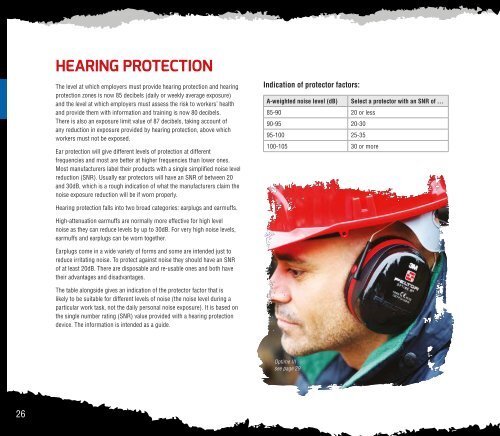Main-Man-Product-Catalogue-2015
Main-Man-Product-Catalogue-2015
Main-Man-Product-Catalogue-2015
You also want an ePaper? Increase the reach of your titles
YUMPU automatically turns print PDFs into web optimized ePapers that Google loves.
HEARING PROTECTION<br />
The level at which employers must provide hearing protection and hearing<br />
protection zones is now 85 decibels (daily or weekly average exposure)<br />
and the level at which employers must assess the risk to workers’ health<br />
and provide them with information and training is now 80 decibels.<br />
There is also an exposure limit value of 87 decibels, taking account of<br />
any reduction in exposure provided by hearing protection, above which<br />
workers must not be exposed.<br />
Ear protection will give different levels of protection at different<br />
frequencies and most are better at higher frequencies than lower ones.<br />
Most manufacturers label their products with a single simplified noise level<br />
reduction (SNR). Usually ear protectors will have an SNR of between 20<br />
and 30dB, which is a rough indication of what the manufacturers claim the<br />
noise exposure reduction will be if worn properly.<br />
Indication of protector factors:<br />
A-weighted noise level (dB) Select a protector with an SNR of …<br />
85-90 20 or less<br />
90-95 20-30<br />
95-100 25-35<br />
100-105 30 or more<br />
Hearing protection falls into two broad categories: earplugs and earmuffs.<br />
High-attenuation earmuffs are normally more effective for high level<br />
noise as they can reduce levels by up to 30dB. For very high noise levels,<br />
earmuffs and earplugs can be worn together.<br />
Earplugs come in a wide variety of forms and some are intended just to<br />
reduce irritating noise. To protect against noise they should have an SNR<br />
of at least 20dB. There are disposable and re-usable ones and both have<br />
their advantages and disadvantages.<br />
The table alongside gives an indication of the protector factor that is<br />
likely to be suitable for different levels of noise (the noise level during a<br />
particular work task, not the daily personal noise exposure). It is based on<br />
the single number rating (SNR) value provided with a hearing protection<br />
device. The information is intended as a guide.<br />
Optime III<br />
see page 29<br />
26


